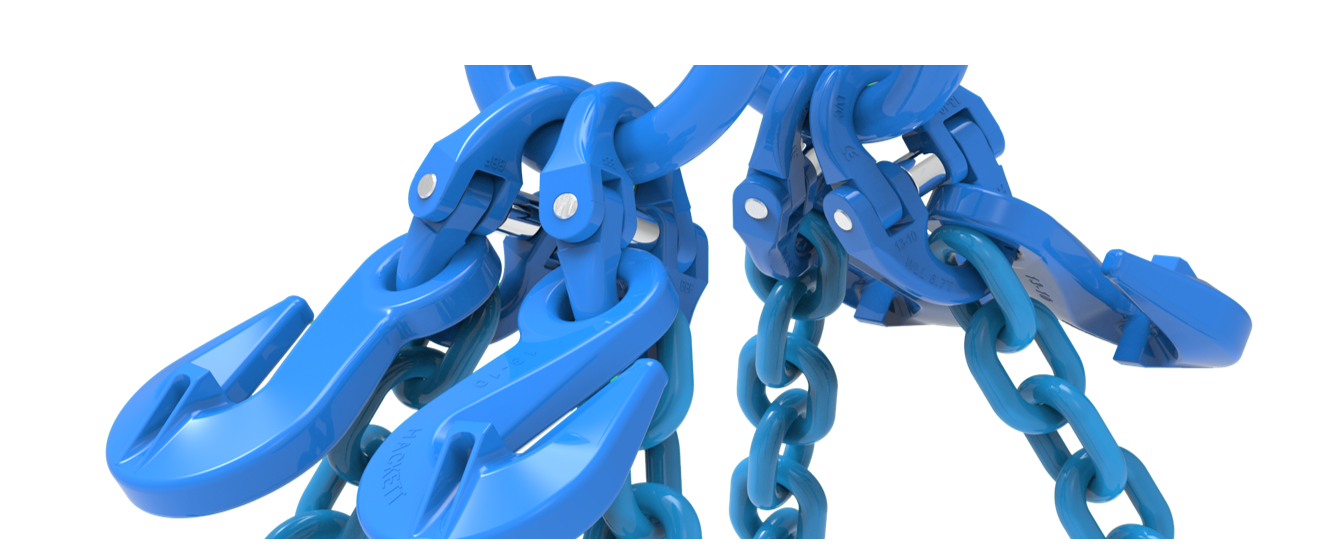In the dynamic landscape of material handling, the choice of chain slings is a critical decision that directly impacts safety, efficiency, and overall lifting success. At Lifting Equipment Store USA, we understand the significance of this choice and are committed to providing insights that empower you to lift with confidence.
Understanding Chain Grades: Grade 80 and Grade 100
The strength and durability of chain slings are categorized into grades, with Grade 80 and Grade 100 being the most common. Grade 100 offers a higher working load limit and increased strength, making it suitable for heavy-duty applications, having a higher Working Load Limit (WLL) means that you get a lighter assembly with a higher capacity when compared to lower grade material. Grade 80 is a more cost-effective solution and the material has a higher level of elasticity making it a favorite in rough construction. Understanding the specific requirements of your lifting task helps in selecting the appropriate grade for optimal performance.
Makeup of a Chain Sling: Single, Double, Triple, and Quad Leg Slings
Lifting Chains come in various configurations to accommodate diverse lifting needs. Whether it's a single leg for straightforward vertical lifts or a quad leg for more complex multi-point scenarios, each configuration offers unique advantages. Choosing the right makeup depends on factors such as load shape, weight distribution, and the desired level of control during lifting.
Adjustable Chain Slings make everyday use a breeze, eye type grab hooks are fitted to the top of the master link- one for every leg of chain (see the above image for a close-up), these enable the rigger to hook back a link of chain which shortens the chain leg to the desired length, thus creating a fully adjustable sling- something that cannot be done with wire rope slings or round slings.
Components Used to Build a Chain Sling
A chain sling is a carefully crafted assembly of components, including master links, connecting links, and various types of hooks (typically end hooks and grab hooks). The quality and compatibility of these components are pivotal in ensuring the integrity and strength of the entire sling. Components are typically connected using a pin connection type (Clevis) while others are welded, each has it's advantages and disadvantages but Clevis connections are our choice method when it comes to building chains, they provide riggers and workshops the ability to switch out and replace worn components or perform modifications to a system without cutting and welding which can result in a loss of length if you need to cut out a link of chain to replace the hook fitting for example.
Hook Types Available: Sling Hooks, Self-Locking Hooks, Foundry Hooks, and C-Hooks
Hooks play a crucial role in the functionality of chain slings. Sling hooks with spring-loaded safety latches provide secure connections ensuring that that connecting components remain engaged when the assembly becomes slack.
Self-locking Hooks offer an additional level of safety where the connecting components cannot be forced out of the jaw of the hook, even with pressure that would force through a standard latch, these hooks can also not be opened when the chain is tightly pulled, the chain must be slack in order to open the jaws of the hook- often these hooks are called "safety hooks" for that very reason,
Foundry hooks are designed for operation in foundry's, they do not have safety latches and feature a larger opening and C-hooks provide versatility in handling various load shapes.
Selecting the right hook type is essential for the success of your lifting operations.
Testing and Tagging: Ensuring Quality and Traceability
Our chain slings undergo rigorous in-house testing and quality assurance in Houston, TX, where each chain leg is subjected to a load test at 2.5 times their working load limit. This meticulous testing ensures that each chain leg can handle the intended workload safely. Additionally, our slings are tagged with steel-engraved tags, providing essential information such as unique serial numbers, working load limits, and manufacturer details. This commitment to traceability ensures transparency and accountability throughout the lifespan of the sling assembly.
Importance of Traceability: Mitigating Safety Risks
In an industry flooded with poor-quality imports, traceability becomes a paramount concern. Knowing the origin of your chain slings is crucial for mitigating safety risks associated with substandard materials and manufacturing processes. At LES USA, we prioritize quality, ensuring that our rigging chains meet the highest standards, providing you with peace of mind and confidence in every lift.Choosing the right sling chain involves a thoughtful consideration of factors such as grade, makeup, components, and testing procedures. By understanding these elements, you can navigate the diverse options available and make informed decisions that elevate your lifting operations. At Lifting Equipment Store USA, we are your trusted partner in lifting with confidence, offering a range of high-quality chain slings designed to meet the demands of your unique lifting needs.

